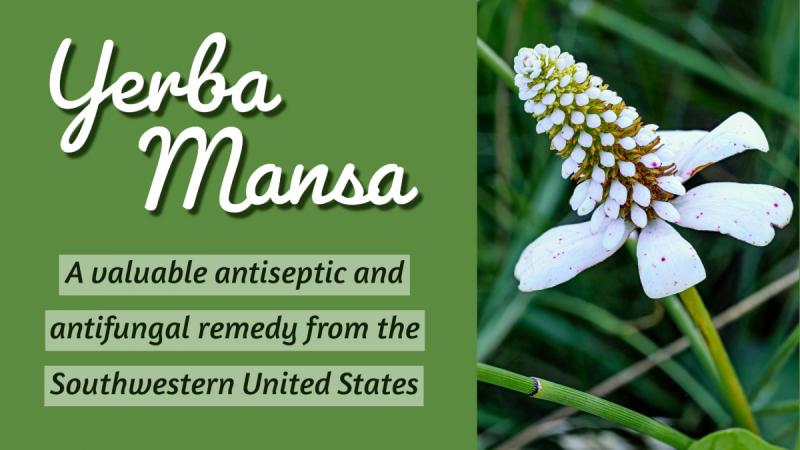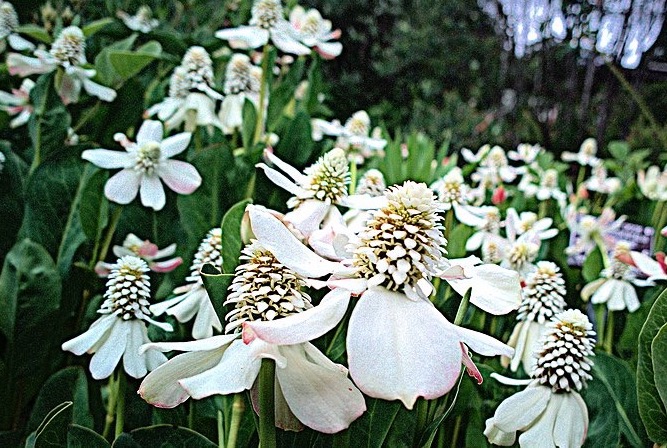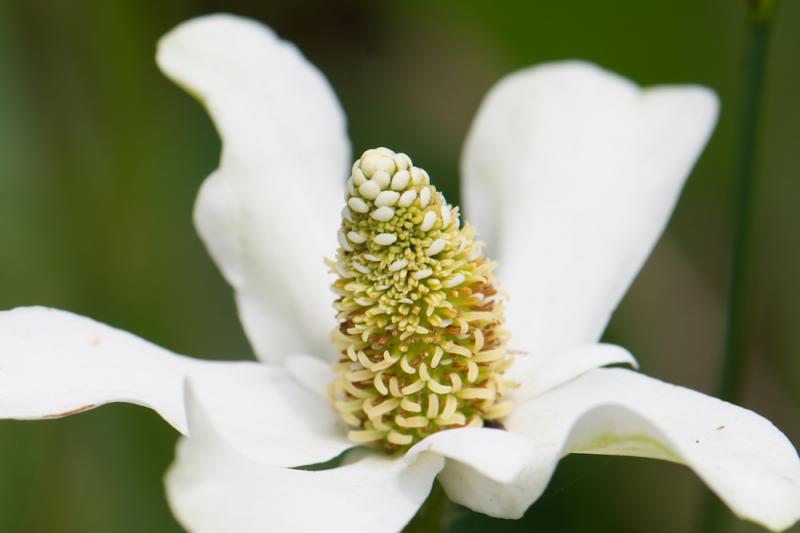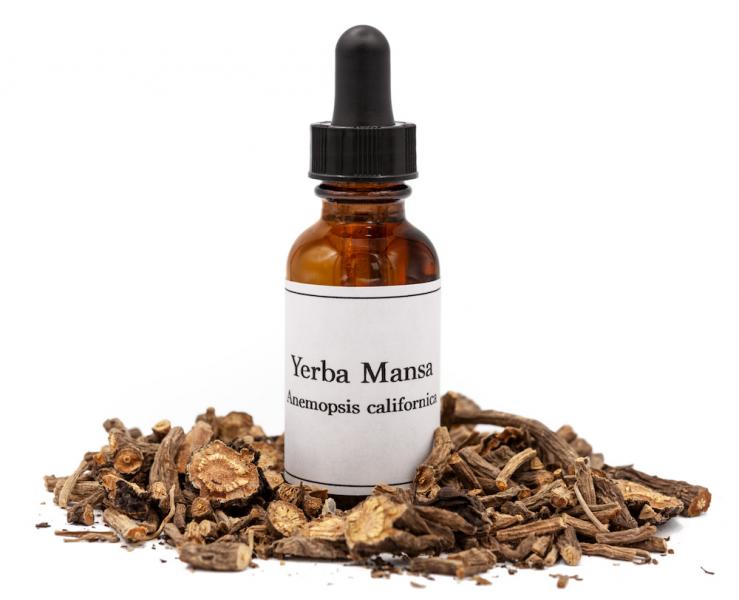
It’s no secret that I love plants. Whenever I’m hiking or even driving past an area I’m constantly observing various species and making mental notes about the ones I know and the ones I don’t know. I also periodically flip through pages of photos in plant identification books, again noting ones I’ve seen in the wilds and ones I haven’t. Right near the entrance to the freeway by the area of Leeds, Utah where I used to live, I spotted a plant with white flowers growing in a slightly marshy area. From a distance, it looked like a member of the Asteraceae or composite family and I often intended to stop and try to find a way into the area where it was growing to get a closer look. Unfortunately, I was usually heading to work or heading home when I saw it and just didn’t feel like I had the time.

When I went to the Desert Springs Preserve in Las Vegas I saw the plant in their botanical garden and discovered it was called Yerba Mansa (Anemopsis californica). I immediately saw it was not a composite flower, but thought, “I’ve seen that plant in my field guides.” When I got home, I thumbed through them and found some information about it in Michael Moore’s Medicinal Plants of the Desert and Canyon West.
From that and other sources, I discovered it was an antiseptic, antibacterial, and antifungal plant that can be used in a similar manner to goldenseal, which I wrote about a couple of weeks ago. I also discovered I could get the tincture from some of the companies where I get my tinctures.
About Yerba Mansa
Yerba mansa is in the lizard’s tail family (Saururaceae), which is a very small family of three genera and six species, so it’s no wonder I didn’t identify the family at first glance. It typically grows in swampy environments in the Southwestern United States, preferring alkaline or slightly saline soils. It can tolerate full sun or partial shade.
Yerba mansa blooms from early spring into late summer, but the flowers don’t readily produce seeds. So, it primarily reproduces by spreading rhizomes, which is why it grows in dense patches like the one I saw near the freeway onramps and offramps. The roots can be dug at any time but are best if harvested in the fall.
Properties of Yerba Mansa
 Like goldenseal, yerba mansa is helpful for conditions where there is subacute inflammation, which involves tissue stagnation (swelling and poor lymphatic drainage) and infections that are not healing. It is particularly helpful for mouth, gum, and throat sores, and skin ulcerations. The difference is that goldenseal relies primarily on bitter alkaloids like berberine, whereas yerba mansa is aromatic, which makes it more warming. The aroma is camphoric and vaporous with a woody, spicy nature and a somewhat eucalyptus-like smell.
Like goldenseal, yerba mansa is helpful for conditions where there is subacute inflammation, which involves tissue stagnation (swelling and poor lymphatic drainage) and infections that are not healing. It is particularly helpful for mouth, gum, and throat sores, and skin ulcerations. The difference is that goldenseal relies primarily on bitter alkaloids like berberine, whereas yerba mansa is aromatic, which makes it more warming. The aroma is camphoric and vaporous with a woody, spicy nature and a somewhat eucalyptus-like smell.
Yerba mansa is also a diuretic and an alkalizing remedy, so it may be helpful for urinary tract infections. It may also help inflammatory conditions like arthritis. Its warming nature also makes it helpful for lung problems like coughs and asthma. The freshly dried roots have also been used for poultices to help heal cuts and sores.
Using Yerba Mansa
 While I haven't yet found the time to go and dig some up, I have purchased and experimented a little with the tincture. It seems to work pretty well. If you want to harvest it, you should to make a 1:5 tincture of the fresh roots in 60% alcohol. The aromatics dissipate rapidly if you dry it and grind it, so it’s not a good herb for capsules or dried powder.
While I haven't yet found the time to go and dig some up, I have purchased and experimented a little with the tincture. It seems to work pretty well. If you want to harvest it, you should to make a 1:5 tincture of the fresh roots in 60% alcohol. The aromatics dissipate rapidly if you dry it and grind it, so it’s not a good herb for capsules or dried powder.
You can apply the tincture topically or take 20-60 drops diluted in water or juice several times a day. You could also dilute some in water and use it as a gargle or mouthwash for gum infections and sore throats.
One of the things I love about herbalism is that you’re always learning something new. I’ve been studying edible and medicinal plants for over 50 years and it’s exciting when you find a new herb you know nothing about. So, even if you’re like me and don’t have a lot of time to be wildcrafting or making your own remedies, keep your eyes open to the plants you see and periodically thumb through herb books looking at pictures. You might be surprised to see what’s growing right in the area where you live.
Downloads
Steven's Articles
-

-
The Sensible Use of Caffeinated Herbs
Kola nuts, guarana, and yerba mate and other herbs…
-

-
The Health Benefits and Problems with Coffee
This popular caffeinated beverage can be beneficial…
October
-

-
Understanding Caffeine & Cellular Adaptation
Preserving the power of caffeine's buzz and the…
September
-

-
Horseradish
A pungent spice for aiding protein metabolism…
-

-
Banaba or Crepe Myrtle
A beautiful tree from Southeast Asia whose leaves…
August
-

-
Monkeyflowers
Flower essences to help see ourselves more clearly…
-

-
Mariposa Lilies
Strengthening the bond between mother and child…
-

-
The Noble Bay Leaf
A common kitchen herb for aiding digestion and…
-

-
Epimedium: Horny Goat Weed
A circulatory stimulant and kidney yang tonic…
July
-

-
The Medicinal and Nutritional Benefits of Apricots
A nutritious fruit and valuable medicinal seed for coughs
-

-
Dogwoods
Asian dogwood is used to stop excessive discharge,…
June
-

-
Neem: The Village Pharmacy
A popular Ayurvedic remedy for dental and immune…
-

-
Spilanthes: The Toothache Plant
A traditional remedy for teeth and gums, as well…
-

-
Forsythia
An anti-inflammatory, fever-reducing, and infection fighting herb
May
-

-
Buckwheat (Kashi)
A delicious, high protein, gluten-free, gut-healthy food

